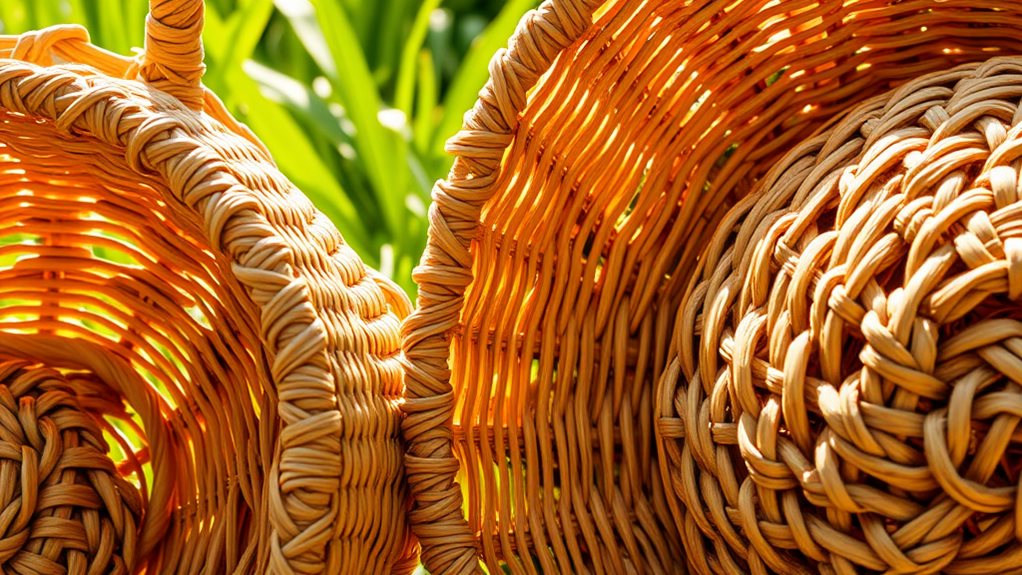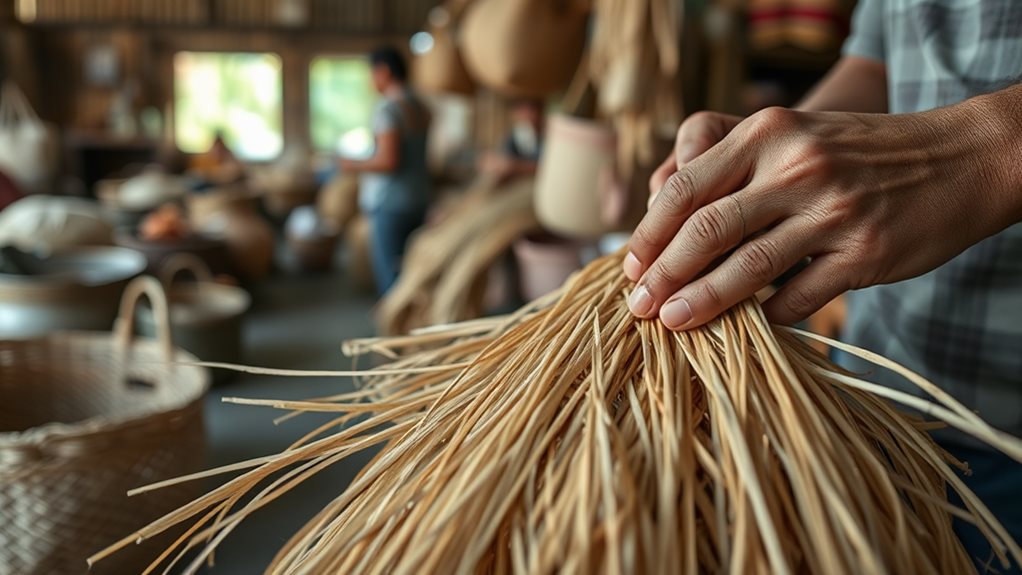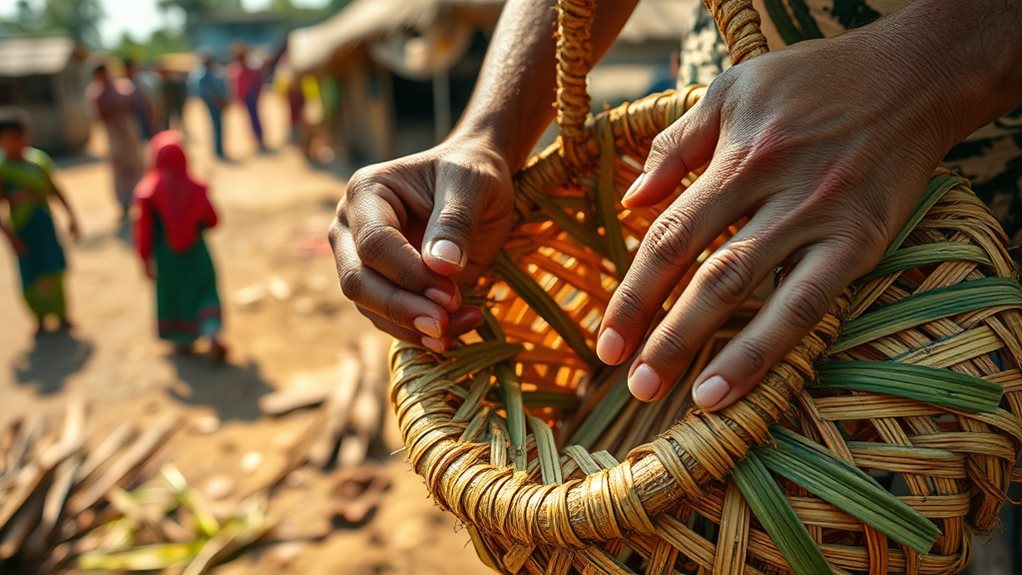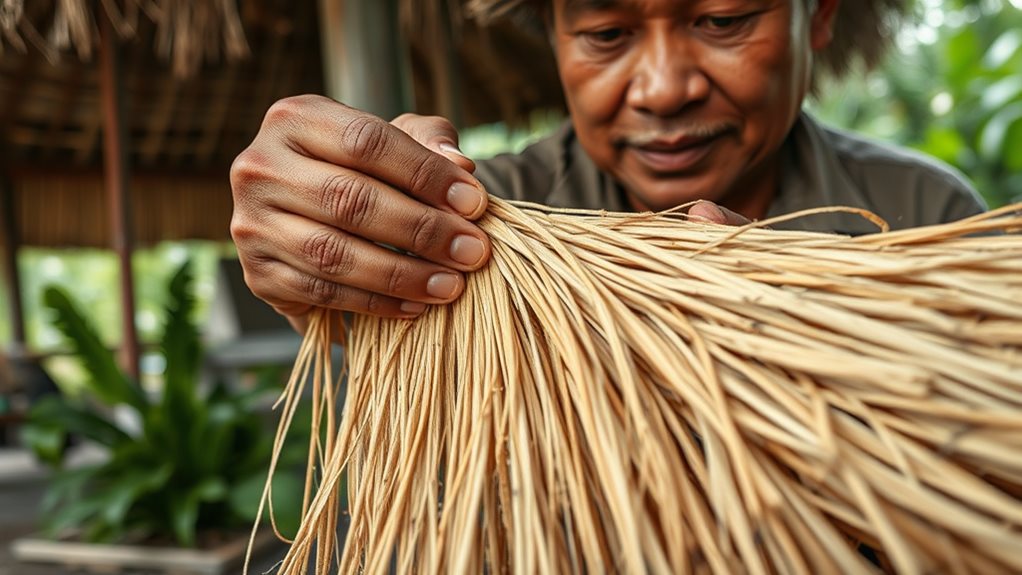Sustainable Filipino craft practices effectively combine traditional techniques with eco-friendly methods. These practices use natural materials, such as bamboo and abaca, to minimize environmental damage. For example, bamboo is used to create durable and versatile products like baskets, furniture, and even musical instruments. Abaca, a type of plant fiber, is used to create ropes, bags, and other textiles.
These sustainable practices provide essential income for rural communities. Local economies are supported, and cultural heritage is preserved through the continuation of traditional crafts. In the Philippines, rural communities rely heavily on sustainable craft practices as a source of income.
Innovative techniques transform waste into beautiful and functional art. Traditional skills are enhanced by modern methods, creating unique products with global appeal. For instance, discarded materials like plastic bottles and old CDs are transformed into decorative items, such as wind chimes and jewelry.
The result is a vibrant tapestry of artistry and sustainability. Sustainable Filipino craft practices showcase the country's rich cultural heritage while promoting environmental responsibility.
Sustainable Materials

Eco-friendly materials are at the core of sustainable Filipino crafts**. This focus on environmentally conscious sourcing results in the creation of stunning pieces with readily available biodegradable alternatives. For instance, eco-friendly resin** derived from renewable plant-based materials is biodegradable, non-toxic, and emits fewer VOCs. This makes it a suitable choice for jewelry, home décor, and mixed media art. Suppliers like RICHSON'S Trading offer this eco-friendly material.
Bamboo is a highly sustainable material**. As a cornerstone of Philippine culture since pre-colonial times, bamboo offers a versatile and biodegradable option for furniture, home décor, clothing, and construction. Its strength ensures durable, long-lasting products, and its use contributes to sustainable practices**, mitigating flood and soil erosion.
Recycled materials play a significant role in sustainable crafts. Transforming plastic, metal, paper, glass, and fabric scraps into sculptures, mosaics, installations, and more demonstrates environmental responsibility and creative repurposing. Techniques such as cutting, molding, melting, and assembling highlight Filipino ingenuity and resourcefulness.
Handmade paper products emphasize eco-conscious sourcing. Using ethically sourced abaca fibers, cogon grass pulp, and pineapple leaves reduces reliance on timber. These biodegradable alternatives create stationery, packaging, and home accents, showcasing design innovations like paper ceramic and paper stitching.
The global recognition of these products speaks to their quality and sustainability.
Environmental Advantages
Filipino craft practices prioritize eco-friendly materials and processes, significantly reducing environmental harm. These practices mainly utilize bamboo and rattan, which are highly renewable resources. The use of these materials leads to a marked reduction in waste. For instance, upcycling initiatives transform waste materials into valuable products, thus diverting them from landfills and minimizing pollution.
Bamboo has a lower carbon footprint than materials like plastic and metal, contributing to climate mitigation efforts. Compared to traditional materials, bamboo boasts a lower carbon footprint due to its rapid growth rate and minimal processing requirements. The durability of rattan furniture also reduces waste by lessening the need for frequent replacements.
Furthermore, eco-friendly businesses that support these practices actively implement recycling and waste management practices.
Sustainable practices contribute to the conservation of natural resources. Bamboo forests act as potent carbon sinks, releasing up to 35% more oxygen than comparable tree stands. Unlike hardwoods, bamboo can be harvested every three to five years due to its rapid growth rate.
Rattan sourcing from sustainable forests promotes biodiversity, and its cultivation and processing require minimal resources. Additionally, sustainable practices conserve water and enhance energy efficiency in production.
Bamboo plays a crucial role in climate mitigation. Bamboo processing demands far less energy than traditional materials like concrete and steel. Using bamboo in construction reduces greenhouse gas emissions during production.
Upcycling lowers raw material demand, fostering a circular economy. Moreover, bamboo's fast growth rate aids carbon sequestration, directly combating climate change. Eco-friendly businesses utilizing energy-efficient processes further reduce their environmental impact.
Economic Impact

Sustainable craft practices contribute significantly to economic growth and social upliftment in the Philippines.
Sustainable Filipino craft practices aren't only environmentally sound but also create income opportunities in rural communities. For example, coconut husk suppliers receive prompt payments upon delivery, while pandan farmers supplement their income through collective efforts.
Woodcarvers in Paete generate income and create employment opportunities, shaping their own economic destinies.
The direct impact of sustainable craft practices on poverty reduction and rural economies is substantial.
Agribusinesses supporting sustainable farming practices enhance economic resilience, while initiatives like the Paete Heritage Crafts Route boost tourism, injecting essential funds into the local economy.
Locally crafted goods contribute considerably to overall community well-being. For instance, hundreds of people find work in coconut husk processing alone.
Promoting local crafts increases their market visibility and appeal.
Collaborations with international brands expand market reach, showcasing the unique appeal of Filipino craftsmanship.
For example, government support and policies amplify the benefits of sustainable craft practices, shaping a favorable environment for growth.
This allows local artisans to control pricing and product management, enabling them to shape their economic futures.
As a result, traditional skills and modern market demands are balanced and supported.
Cultural Preservation
Filipino craft practices play a vital role in preserving cultural heritage**. They reflect the unique artistry**, traditions, and beliefs of various indigenous groups, acting as powerful vehicles for heritage transmission. These crafts are tangible expressions of cultural storytelling, allowing cultural practices to be passed down through generations.
For example, traditional weaving techniques have been revived, with ancient skills being mastered and refined to ensure their continued existence.
The fusion of traditional and modern designs creates unique textiles****. Ancient weaving techniques blend seamlessly with modern designs, creating unique and culturally noteworthy textiles.
Similarly, woodcarving techniques creatively fuse traditional folklore with contemporary styles. This blend of old and new is also seen in metalwork heritage projects, which revive ancient techniques like filigree and repoussé.
Hands-on learning opportunities facilitate heritage transmission. The "Master and Apprentice" initiative and Cultural Heritage Workshops provide a platform for artisans to learn from experienced craftsmen, ensuring the continuation of traditional skills.
These programs allow for creativity and innovation, enabling the incorporation of traditional skills into modern art forms while preserving cultural identity.
Preserving cultural heritage contributes to ongoing cultural storytelling**. By supporting these initiatives and learning traditional skills, people contribute to the enduring legacy** of Filipino craftsmanship.
This, in turn, ensures that the cultural importance embedded within each craft is passed down through generations.
Community Support

Community Support is Crucial for Filipino Craft Practices****
Filipino craft practices rely heavily on strong community support, which provides economic and social benefits to artisans and their communities. This support comes in various forms, including partnerships with organizations that empower local artisans.
Love, Camille and Boho Manila are examples of such partnerships, which have enabled Ilocos Sur artisans to turn their handwoven inabel into fashionable clothing and created livelihood opportunities for mothers.
Community engagement also extends to fair trade practices, which ensure that artisans receive fair wages for their work.
GIFTS & GRACES and KAMAY KRAFTS are two organizations that promote fair trade practices by bridging the gap between skilled communities and markets. They do this by providing mentorship and resources to marginalized communities and facilitating partnerships between them and entrepreneurs.
Artisan collaboration is another key aspect of community support in Filipino craft practices.
Initiatives like "Linking landscapes to Cultural Creative Sustainability" enhance skills and market access through digital platforms and craft skill exchanges. This approach has been adopted by organizations like Kultura's Filipino Design Studio, which highlights local craftsmanship and sustainable practices.
The importance of community support is also evident in the way it promotes sustainable practices.
Papemelroti's workshops share talents and income generation, including partnerships with organizations aiding dialysis patients. Similarly, the Tina Weaving Community engages in participatory research, supporting sustainable resource management and improved livelihoods.
Innovative Techniques
Innovation in Filipino Craft Practices
Strong community support is crucial for the success of Filipino craft practices. However, innovation in techniques is equally important for their continued growth and sustainability.
Eco-Friendly Innovation Revolutionizes Traditional Methods****
Filipino craft practices are witnessing an eco-friendly innovation revolution. Waste materials are being transformed into valuable resources. For instance, coconut shells are turned into decorative items, while bamboo is transformed into musical instruments and textiles.
Discarded tarpaulins and fabric are also being repurposed into stylish bags and home décor. This creative reuse isn't only eco-conscious but also ingenious.
Innovative Product Development
Innovative product development is also taking place alongside this eco-friendly innovation. Coconut shells are being sculpted into bowls and jewelry, showcasing skillful craftsmanship.
Bamboo is finding new life as reusable straws and food containers. Upcycled materials are being combined to create unique and functional products. Handmade paper, crafted from abaca fibers and cogon grass pulp, is being used to create elegant stationery and lighting fixtures.
Enhancing Traditional Methods
This eco-friendly innovation isn't replacing traditional methods but enhancing them. Traditional Filipino motifs are being woven into bamboo designs, preserving cultural heritage while incorporating modern materials.
Handloom weaving traditions are being revitalized with the integration of bamboo yarns, showcasing a beautiful blend of the old and new. Traditional paper-making techniques are being adapted to create intricate vessels and vases.
Scientific advancements are further enhancing these processes, improving efficiency and product quality.
Collaboration for Sustainable Practices
Collaboration with the Department of Science and Technology and tech-driven brands is guaranteeing sustainable practices.
This ensures that continued support for these eco-friendly innovations promotes environmental sustainability.
Artisanal Skills

Filipino artisanal skills are a rich expression of the country's diverse cultural heritage and regional identities****. These skills have been passed down through generations, reflecting the unique techniques and traditions of different regions.
Traditional weaving is a prominent artisanal skill in the Philippines. For example, intricate banig weaving is found in the Visayas, where artisans use pandan and buri to create beautiful patterns. Inabel weaving from Ilocos is another notable example, showcasing the cultural significance of these crafts. The vibrant malongs of Mindanao's Maranao people are also a testament to the rich textile heritage of the country.
Bamboo craftsmanship and pottery are other significant artisanal skills in the Philippines. Bamboo is transformed into furniture and baskets, demonstrating the versatility of this material. Pottery techniques, such as coiling, wheel-throwing, and hand-building, are employed to create beautiful and functional pieces. Vigan's distinctive pottery is a notable example of regional specialization.
Metalwork and woodcarving are also important artisanal skills in the Philippines. Metalwork encompasses filigree and repoussé, adding another layer to the country's rich artistic heritage. Mindanao's metalwork exhibits unique geometric designs.
Woodcarving, particularly in Paete, Laguna, is renowned for its detailed and intricate designs, often used in religious icons.
Preservation efforts are underway to ensure the longevity of Filipino artisanal skills**. Artisan workshops dedicated to skill transfer are helping to preserve these traditional techniques. Initiatives reviving traditional weaving**, developing pottery skills, and establishing woodworking apprenticeships are also being implemented.
Cultural heritage workshops offer immersive experiences, allowing participants to learn these techniques firsthand. These projects aim to maintain the legacy of Filipino artisanal skills by blending traditional methods with modern approaches****.
Eco-Friendly Practices
Environmental sustainability is a key component of many successful Filipino craft practices, balancing economic viability with ecological responsibility. Ethical sourcing is at the heart of these initiatives. For instance, Filipino craftspeople use abaca, cogon grass, and pineapple leaves to create tree-free paper. Additionally, they transform upcycled fabric scraps into stylish bags and utilize locally-sourced materials such as seagrass, raffia, and crocheted flowers.
Effective waste management is also crucial in these eco-friendly practices. Recycling and upcycling are used to minimize waste. Papemelroti and Kamay Krafts, for example, use recycled paper to create high-quality products. INDIGENOUS utilizes a simple fruit blender to produce homemade paper, while Kultura's partner brands focus on efficient material utilization to reduce waste.
Beyond material selection, energy and water conservation are also essential components. Papemelroti's initiatives demonstrate a broader commitment to environmental stewardship by promoting energy and water conservation. Their Planet Patrol program raises public awareness about ecological concerns, emphasizing the importance of alternative materials and minimizing deforestation to maintain ecological balance.
This approach ensures continued production while supporting local artisans and their livelihoods through fair wages and empowering underserved communities.
Filipino Craftsmanship

Filipino Craftsmanship: A Blend of Tradition and Innovation****
The Philippines, an archipelago in Southeast Asia, is home to a diverse array of traditional craftsmanship that showcases the country's rich cultural heritage.
Textiles and Weaving
Traditional Filipino textiles are known for their vibrant colors and intricate patterns.
Piña weaving from Aklan and Inabel from Ilocos are two examples of traditional weaving techniques that have been passed down through generations. These textiles are often made from natural fibers such as piña and cotton, and are used to create clothing, scarves, and other accessories.
The Maranao people's malongs, which are traditional skirts made from colorful fabrics, are another example of the country's rich textile heritage.
Woodcarvings and Bamboo Crafts****
Woodcarvings are a significant part of Filipino craftsmanship, with Paete being a renowned hub for intricate woodcarvings.
Paete's woodcarvings are known for their intricate designs and are often used to create religious icons and furniture. Bamboo, a readily available resource in the Philippines, is also used to create a variety of crafts such as baskets, furniture, and musical instruments like the karaga guitar.
Metalworking and Jewelry****
Metalworking is another area where Filipino craftsmanship excels.
Intricate jewelry, iron-tipped spears, and brass bells are just a few examples of the country's metalworking expertise. Shellwork, particularly in Cebu, transforms mother of pearl into exquisite jewelry and furniture.
Goldsmithing is also a cherished traditional art in the Philippines, with the Bagobo people creating intricate gold jewelry adorned with geometric motifs.
Pottery and Basketry****
Pottery is another traditional craft in the Philippines, with influences from Chinese and other Asian styles.
Vigan and Guimaras are two places in the country known for their pottery traditions. Basketry is also a significant part of Filipino craftsmanship, with grasses, twigs, and other natural materials used to create baskets and other functional items.
Modern Adaptations
While traditional craftsmanship remains crucial, modern adaptations of these techniques are also emerging.
Filipino craftsmen are combining traditional techniques with contemporary designs to create unique and innovative products****. This blending of old and new is helping to keep the country's traditional craftsmanship alive and relevant in the modern era.
Questions and Answers
Where Can I Buy These Crafts?
You can buy these crafts at local artisan markets, online platforms, or select retail stores. These stores include Etsy, eBay, and Amazon. Examples of local artisan markets include farmers' markets, craft fairs, and holiday markets. When shopping, look for eco-friendly materials. Supporting sustainable practices is also key; choose stores that use recyclable packaging and environmentally friendly shipping methods.
How Are the Crafts Shipped?
Regional and international shipments prioritize eco-friendly practices.
Our shipping methods prioritize minimizing carbon footprint through eco-friendly packaging. Regionally, we use local distribution networks to reduce emissions. For international shipments, we partner with sustainable carriers to ensure environmentally responsible transportation.
Do You Offer Custom Orders?
Yes, some brands offer custom design options. These options typically involve personalized crafting techniques that cater to individual preferences. For instance, a brand may allow customers to choose specific materials or colors for their products.
Not all brands offer custom orders, though. In some cases, brands may accommodate bespoke requests, but this is not always the case. To determine if a brand offers custom orders, it's best to contact them directly and inquire about their customization policies.
What Is Your Return Policy?
Our return policy is not explicitly stated. We have not established a standard refund process or specific conditions for exchanges. If you need to return or exchange an item, contact us directly to discuss your individual circumstances.
How Long Does Production Take?
The length of production time varies. This variation is due to two main factors: the intricacy of the chosen crafting techniques and the sourcing of production materials. For example, a simple design with locally sourced materials might be produced within a few days, while a complex design can take several weeks or even months to complete. This is because intricate crafting techniques often require more time and labor, and sourcing materials from distant locations may involve longer lead times.